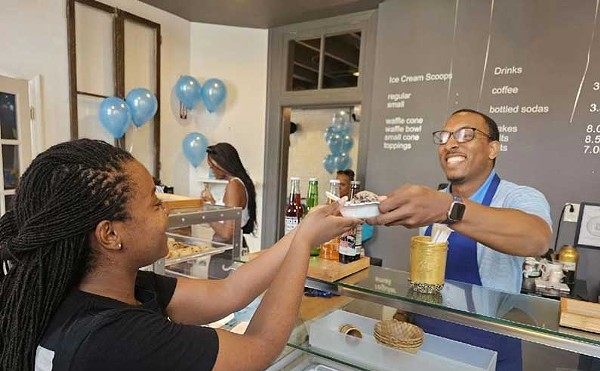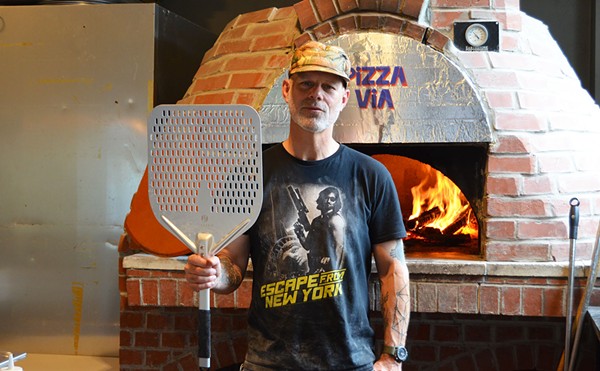We'd just gotten back from Rooster when my friend posed the question. I assumed it was a joke. In my experience, only the very young or the very, very stoned wonder out loud whether animals in different countries speak different languages.
But my friend was serious. "They say cocorico."
It's true, too (of the French, if not of the roosters themselves).
And I think I prefer the French interpretation. Cocorico sounds much more noble than cock-a-doodle-doo. Which makes sense. Here, the rooster is a struttin' alarm clock. In France, it's a national symbol.
Of course, it's no secret that the French are more refined when it comes to, well, pretty much everything. Consider the humble pancake. As with dumplings, wherever there are people, there are pancakes: boxty, latkes, buckwheat blini topped with sour cream or even caviar, bao bing wrapped around Peking duck, a short stack at your favorite diner slathered with butter and drowned in syrup. There's a good reason millions will feast on pancakes this coming Tuesday before the Lenten fast.
Pancakes rule.
But the French had to go and refine even this simple pleasure. Crêpes are ethereally light, supple enough to pair with chocolate or cheese, fruit or meat, and delicious enough to eat plain. Yet — and this is a mark of how seriously the French take everything food-related — crêpes are still a street food. You buy them from vendors on the sidewalk or crêperies no bigger than an airport Starbucks kiosk.
Dave Bailey figured it was time downtown St. Louis had a crêperie of its own, so the 28-year-old owner of Lafayette Square's Baileys' Chocolate Bar opened Rooster in late November. Crêperies per square mile might not be your first measure of downtown's resurgence as a place to live and work, but it's a better barometer than you think. Rooster works fine as a lunch-hour destination — and during my visits a decent number of business types stopped in — but it feels like a neighborhood café, a place to sit with a cup of strong black Kaldi's coffee on a chilly morning and read the paper, or just watch your breath fog the windows while you wait for your meal.
True, Rooster's windows look out on a parking lot. Use your imagination, though. A few blocks north are Washington Avenue's lofts, and right next door to Rooster is a store filled with the kind of high-design furniture and knickknacks that would look terrific inside of one of those apartments or condos. In fact, when I spoke to Dave Bailey on the phone, he told me Rooster added weekend hours because of demand from neighborhood residents.
Rooster is bigger than an airport Starbucks kiosk — though not by much. You enter into a room twice as long as it is wide. On your right is the handsome wood service counter; on your left large mirrors line the wall. The space was Kelly's Deli before it was Rooster, but years before that it was a men's barber shop (hence the mirrors), and Bailey told me he wanted its new design to evoke its former Art Deco feel.
You follow the fast-casual model: Order at the counter, take a number, sit down. Finding a seat is the greatest challenge at Rooster. The dining room is a tad wider than the first room, but half as long. Calling it cozy would be a stretch. It seats maybe twenty. If this is full, you can squeeze yourself into a seat along the narrow ledge that runs below the mirrored wall or into a seat along the slightly less narrow ledge at the front windows.
Actually, fast-casual is a bit of a misnomer. The service isn't slow, but it's not assembly-line speedy. Let's call it casual-fast. Sometimes the person who took your order brings it to your seat, sometimes a waiter does, sometimes the cook does, sometimes Dave Bailey does. Which is to say it's refreshingly low-key, and if you do wait a little longer than you might at a true fast-casual joint, it's usually worth it.
Rooster's menu features twenty savory crêpes and eleven sweet crêpes along with salads, soups and sandwiches. Bailey himself ran the kitchen for Rooster's opening weeks; he has now turned it over to Stephen Trouvere, formerly a sous chef at Pomme in Clayton. They turn out crêpes that are a lovely golden brown, modestly sweet and, unfolded, quite large. Both the savory and sweet crêpes are folded into wedges, the savory crêpes stuffed so full they look like a cross between a burrito and a quesadilla.
Of all the savory crêpes I had, one with slices of "German-style" sausage and Vermont cheddar was best, a triumph of balance between the mild sausage, sharp (but not overly so) cheese and the delicate crêpe. Nearly as good was the "Brie #4," with roasted apple slices, toasted pecans and crème fraèche. "Nearly" because the apple slices had been heavily spiced with clove, which gradually overwhelmed the other flavors.
With the exception of the sausage-and-cheddar crêpe, each savory crêpe is a numbered variation on one of seven main ingredients: egg, bacon, goat cheese, roasted ham, Brie, "marinated spicy chicken" and roasted sirloin. These definitions are fluid, though. "Egg #4," for example, was notable for large pieces of crisp, flavorful bacon, while the sirloin in the "Roasted Sirloin #2" was blown away by exceptionally strong blue cheese. The pairing might have worked had the sirloin not been well done. As it was, the flavor was more cheese-on-toast than cheese-and-meat. And the crêpe itself didn't stand a chance.
The sweet crêpes were petite compared to the savory, and a simple lemon crêpe was practically a size zero. Actually, I liked the lemon crêpe very much. Its light flavor reminded me of a fortune cookie: a little vanilla, a little citrus. It would have gone well with Serendipity's dark-chocolate ice cream (one of several flavors available on its own or with a crêpe) had it not been twenty degrees outside.
Though the "Peanut Butter Cup" crêpe was about the same size as the lemon, it was so rich with dark chocolate and thick peanut butter that it seemed twice as big. A crêpe of figs poached in liquor — brandy or rum, I'd guess — with toasted pecans was almost as savory as it was sweet. Both were good, but you should consider each a meal by itself, rather than a dessert course.
After 11 a.m. Rooster offers several sandwich selections in addition to its crêpes. Here I had considerably less luck. The pork in a pulled pork sandwich was very tender (Rooster uses hormone- and antibiotic-free beef, pork and chicken from local sources), but it came in a barbecue sauce too sweet for my tastes, though I liked its gradual heat. The roasted ham on a croque monsieur was also quite good, but the sandwich itself was a disappointment. In fact, it wasn't a croque monsieur. It hadn't been grilled. The roasted ham and Gruyère cheese — there were also supposed to be caramelized onions, but on my sandwich they were sparse — were served on a soft, fresh roll instead. A sandwich with marinated chicken was an outright disaster, swampy with mayonnaise and marred by the presence of a chunk of bone.
Though its food needs tweaking here and there, Rooster is a great idea in a perfect spot. The mere fact that the corner of Locust and 11th seems able to support a neighborhood café is something to crow about. Whether you say cock-a-doodle-doo or cocorico is up to you.
Have a suggestion for a restaurant the Riverfront Times should review? E-mail [email protected].





